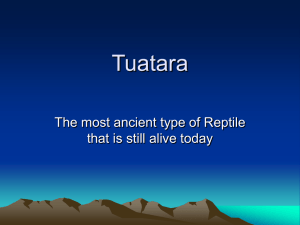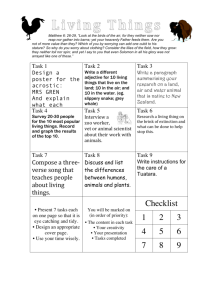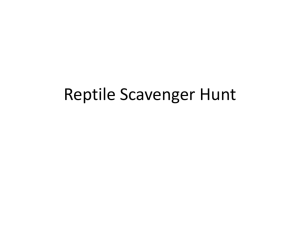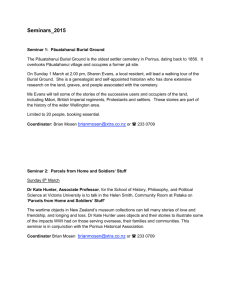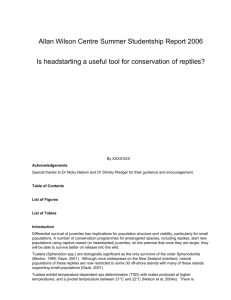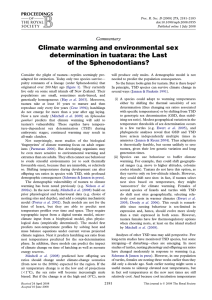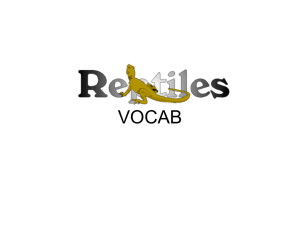Dear Author, Herpetological Review
advertisement
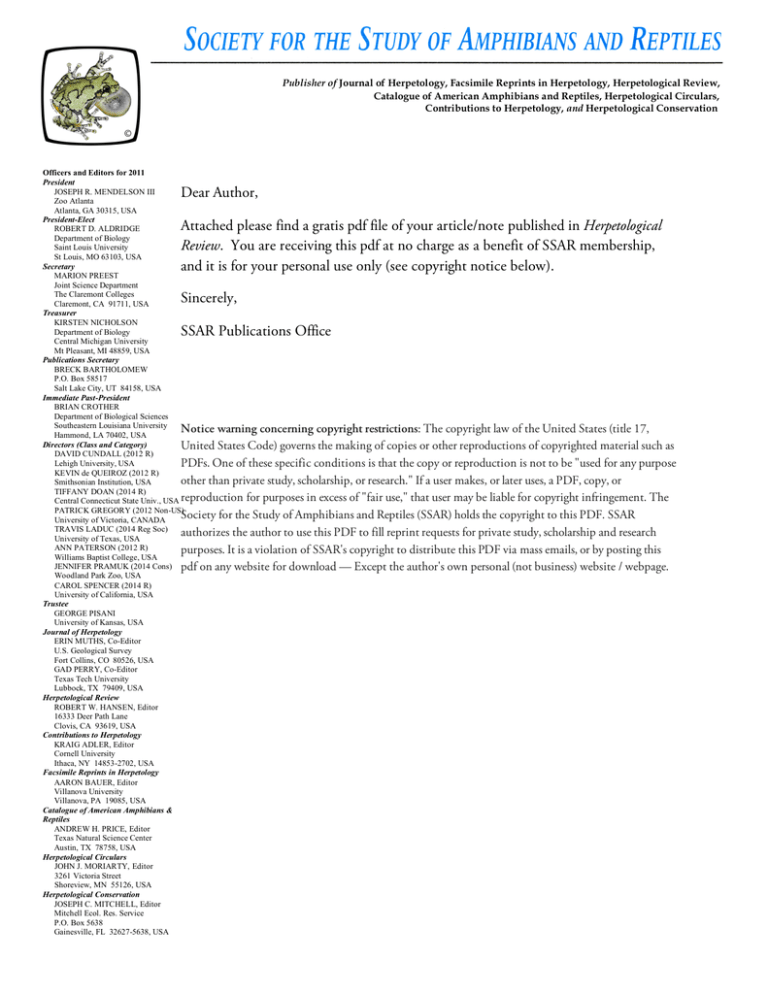
Publisher of Journal of Herpetology, Facsimile Reprints in Herpetology, Herpetological Review, Catalogue of American Amphibians and Reptiles, Herpetological Circulars, Contributions to Herpetology, and Herpetological Conservation Officers and Editors for 2011 President JOSEPH R. MENDELSON III Zoo Atlanta Atlanta, GA 30315, USA President-Elect ROBERT D. ALDRIDGE Department of Biology Saint Louis University St Louis, MO 63103, USA Secretary MARION PREEST Joint Science Department The Claremont Colleges Claremont, CA 91711, USA Treasurer KIRSTEN NICHOLSON Department of Biology Central Michigan University Mt Pleasant, MI 48859, USA Publications Secretary BRECK BARTHOLOMEW P.O. Box 58517 Salt Lake City, UT 84158, USA Immediate Past-President BRIAN CROTHER Department of Biological Sciences Southeastern Louisiana University Notice warning concerning copyright restrictions: The copyright law of the United States (title 17, Hammond, LA 70402, USA Directors (Class and Category) United States Code) governs the making of copies or other reproductions of copyrighted material such as DAVID CUNDALL (2012 R) Lehigh University, USA PDFs. One of these specific conditions is that the copy or reproduction is not to be "used for any purpose KEVIN de QUEIROZ (2012 R) other than private study, scholarship, or research." If a user makes, or later uses, a PDF, copy, or Smithsonian Institution, USA TIFFANY DOAN (2014 R) Central Connecticut State Univ., USA reproduction for purposes in excess of "fair use," that user may be liable for copyright infringement. The PATRICK GREGORY (2012 Non-US) Society for the Study of Amphibians and Reptiles (SSAR) holds the copyright to this PDF. SSAR University of Victoria, CANADA TRAVIS LADUC (2014 Reg Soc) authorizes the author to use this PDF to fill reprint requests for private study, scholarship and research University of Texas, USA ANN PATERSON (2012 R) purposes. It is a violation of SSAR's copyright to distribute this PDF via mass emails, or by posting this Williams Baptist College, USA JENNIFER PRAMUK (2014 Cons) pdf on any website for download — Except the author's own personal (not business) website / webpage. Woodland Park Zoo, USA CAROL SPENCER (2014 R) University of California, USA Trustee GEORGE PISANI University of Kansas, USA Journal of Herpetology ERIN MUTHS, Co-Editor U.S. Geological Survey Fort Collins, CO 80526, USA GAD PERRY, Co-Editor Texas Tech University Lubbock, TX 79409, USA Herpetological Review ROBERT W. HANSEN, Editor 16333 Deer Path Lane Clovis, CA 93619, USA Contributions to Herpetology KRAIG ADLER, Editor Cornell University Ithaca, NY 14853-2702, USA Facsimile Reprints in Herpetology AARON BAUER, Editor Villanova University Villanova, PA 19085, USA Catalogue of American Amphibians & Reptiles ANDREW H. PRICE, Editor Texas Natural Science Center Austin, TX 78758, USA Herpetological Circulars JOHN J. MORIARTY, Editor 3261 Victoria Street Shoreview, MN 55126, USA Herpetological Conservation JOSEPH C. MITCHELL, Editor Mitchell Ecol. Res. Service P.O. Box 5638 Gainesville, FL 32627-5638, USA Dear Author, Attached please find a gratis pdf file of your article/note published in Herpetological Review. You are receiving this pdf at no charge as a benefit of SSAR membership, and it is for your personal use only (see copyright notice below). Sincerely, SSAR Publications Office ARTICLES 19 ARTICLES Herpetological Review, 2012, 43(1), 19–21. © 2012 by Society for the Study of Amphibians and Reptiles Intrasexual Aggression in Tuatara: Males and Females Respond Differently to Same-Sex Intruders Intrasexual aggression patterns may reflect sex-specific strategies for maximizing fitness. Studies of aggression have typically focused on males because their behavior is often more dramatic and their morphology often more conspicuous than those of females (Andersson 1994). However, female intrasexual aggression is widespread and can serve several functions, including (1) competition for male parental care (e.g., preventing mates from courting and attracting other females; Slagsvold 1993; Slagsvold and Lifjeld 1994), (2) defending resources in a territory from other females (Berglund et al. 1993; Schofield et al. 2007), and (3) defending nests from females attempting to destroy them or deposit their own eggs (Bensch and Hasselquist 1994; McPhee and Quinn 1998). Tuatara (Sphenodon spp.) are the last living representatives of the reptilian order Rhynchocephalia; they are endemic to New Zealand, sexually dimorphic, and highly territorial (Daugherty and Cree 1990). Tuatara are polygynous and polyandrous, and clutches can be multiply sired (Moore et al. 2008). Aggression has been documented in both sexes, but experimental studies of intrasexual aggression have only been conducted with male tuatara (Gillingham et al. 1995). Aggressive behaviors among tuatara include erect and alert body posturing, inflation of the gular (throat) region, dorsal and nuchal crest erection, mouth gaping, lateral head shaking, chasing, and physical attack (Gillingham et al. 1995). Physical attacks can last for hours and sometimes end in serious injury. Male and female tuatara display nearly the same suite of aggressive behaviours. However, only males display pronounced dorsal and nuchal crest erection and lateral head shaking. In addition, females exhibit a head nodding behavior that may indicate their sex to other tuatara and thus promote the initiation of male courtship and help females avoid attack by aggressive males during the mating season (Gillingham et al. 1995). Aggressive encounters between male tuatara follow a stereotyped pattern, beginning with alert posturing, body inflation and crest erection, followed by reciprocal mouth gaping and eventually biting and physical combat (Gillingham et al. 1995). Aggressive encounters among males take place throughout the year but are particularly frequent during mating season when testosterone levels peak (March; Cree et al. 1992). Larger males are more effective at monopolizing and guarding mates and territories by winning aggressive encounters with other males (Moore et al. 2009) The extent of female-female aggression during mating season is unknown. However, female tuatara aggressively defend their nest sites from excavation by other females during nesting season (November; Refsnider et al. 2009). Females tuatara display nest-site fidelity, returning to the same communal rookeries outside of their home ranges to oviposit every 2–4 years (Refsnider et al. 2009). A study of intrasexual aggression, during mating season and in both sexes, is necessary for understanding the mating system of tuatara, and previous findings for males cannot be assumed to be true for females. Here we investigate (1) whether female-female aggression occurs during the mating season (8–10 months before nesting; Cree et al. 1992) and (2) if the form and pattern of aggression differs between the sexes. Methods.—We assessed intrasexual aggression through a series of trials conducted during mating season in March 2007 on Stephens Island in Cook Strait, New Zealand, where the largest and most dense population of tuatara (Sphenodon punctatus) occurs (~2700 tuatara per ha; Moore et al. 2009). Tuatara occupy extensive, dense burrow systems. Although nocturnal foragers, tuatara emerge from their burrows during the day to thermoregulate and defend against intruders. Resident male and female tuatara were presented with a non-moving model tuatara representing a same-sex territorial intruder (Fig. 1). Models were carefully placed by hand within territories approximately 1–1.5 m from individual tuatara basking near burrow entrances. Responses of tuatara to the models were either recorded on digital video (19 male trials, 11 female trials) or directly observed when a camera was unavailable (10 female trials). The camera or observer was within view of the focal animal but stationary for the duration of the trial; in very few instances did this process appear to alter the focal animal’s immediate behavior. Trials were scored by one of two observers who similarly identified the suite of behaviors under study. Kristina M. Ramstad* Allan Wilson Centre for Molecular Ecology and Evolution, Victoria University of Wellington, School of Biological Sciences, PO Box 600, Wellington 6140, New Zealand Jennifer A. Moore Department of Fisheries and Wildlife, Michigan State University, 13 Natural Resources Building, East Lansing, Michigan 48824, USA Jeanine M. Refsnider Department of Ecology, Evolution and Organismal Biology, Iowa State University, 251 Bessey Hall, Ames, Iowa 50011, USA *Corresponding author; e-mail: kristina.ramstad@vuw.ac.nz Herpetological Review 43(1), 2012 20 ARTICLES Fig. 1. Realistic (A) and abstract (B) models of male and female (smaller) tuatara. Realistic models were based on molds of deceased tuatara. Abstract models represent only the basic profile and shape of tuatara. Fig. 2. Frequency of aggressive behavioral responses of tuatara to non-moving, same-sex models. Trials (total number conducted) were male tuatara presented with a realistic model (♂R), male tuatara presented with an abstract model (♂A), and female tuatara presented with a realistic model (♀R); data are the number of times each behaviour was observed divided by the total number of trials. Female tuatara showed no aggressive behavior toward abstract same-sex models. Both abstract and realistic models for each sex were used in trials to increase the visual cues offered to the tuatara and maximise the possibility of eliciting a response. Realistic models were created from molds of deceased tuatara, while abstract models represented only the basic profile and shape of tuatara (Fig. 1). Models approximated the size and shape of adult tuatara and were similarly sized within sex. A total of 40 tuatara (19 males and 21 females) were presented with models. Individual tuatara were used in only one trial and were captured when possible after the trial to measure total body length (tip of snout to tip of tail) and snout–vent length (SVL). Trials were conducted between 1100 h and 1800 h; more than 41 h of observation were conducted in total. Encounters between tuatara and models were discreet but varied in duration. Therefore, we did not equalize observation time among trials, but included only trials where the full encounter (tuatara first notices model or emerges from burrow until displaying or attack ceased) was observed (range 30–95 min, mean = 62 min). Data were summarized as counts of response and non-response trials and the frequency in which each behavior was observed (head raise/nod, body inflation, mouth gape, bite) in response trials. Differences in behavior between sexes and model types were assessed with chi square analyses and differences in mean body size between responding and non-responding tuatara were assessed with a two-tailed ttest; significance was assessed at a α = 0.05. Results.—Body size was recorded for 14 of 19 male and 18 of 21 female tuatara used in trials. Total body length of the models (male: realistic = 520 mm, abstract = 415 mm; female: realistic = 310 mm, abstract = 370 mm) was within the body size range of captured male (range 373–593 mm, mean = 480.4 mm + 33.0 95% CI) and female (range 257–427 mm, mean = 364.2 mm + 20.7 95% CI) tuatara, and mean SVL did not differ between tuatara that did and did not respond to the models (males: t12 = 0.036, p = 0.97; females: t16 = -0.490, p = 0.63). Aggressive responses to the models were recorded in 35% of trials (8 of 19 male tuatara or 42%, 6 of 21 female tuatara or 29%) and male and female tuatara were equally likely to respond aggressively to the models overall (χc21 = 0.80, p = 0.37). Female tuatara did not respond to the abstract model while male tuatara responded similarly to both abstract and realistic models (males: χc21 = 0.28, p = 0.60; Fig. 2). Where a response was observed, males and females differed in their type of response (χc23 = 8.98, p = 0.03; Fig. 2). Males tended to engage in head raises and body inflation; in no trial did a male tuatara mouth-gape at or physically attack a model (Fig. 2). Female tuatara showed similar body inflation to males, but engaged in fewer head nods than males and also mouth-gaped at the models and, in two trials, bit them on the head (Fig. 2). Discussion.—Our study suggests that both male and female tuatara are aggressive toward same-sex intruders during the mating season, but that physical attack is more likely among female than male tuatara. This may indicate that the fitness cost of fighting (e.g., risk of injury, lost energy or courting time, tail loss) is lower, or the cost of intrusion is higher, among female than male tuatara. In many birds, females are aggressive toward other females being courted by their mates, which functions to ensure paternal care (Liker and Szekely 1997; Slagsvold 1993; Slagsvold and Lifjeld 1994). Tuatara do not exhibit extensive parental care and do not show pair-bonding. Therefore, female-female aggression in tuatara during the mating season more likely functions as a way to defend individual burrows (i.e., retreat sites) or basking sites, while male-male aggression functions to establish dominance and defend mates. The extremely high density of tuatara in our study population suggests that there could be intense competition for burrows and basking sites. Intrasexual aggression among female tuatara may have evolved in the context of nest defense. Male tuatara have evolved a stereotyped, reciprocal display that only rarely escalates to physical combat (Gillingham et al. 1995). However, female tuatara do not appear to have evolved a similar passive threat display (e.g., like that observed in female Loggerhead Sea Turtles Caretta caretta; Schofield et al. 2007). Outside of nesting, females may rarely come into direct contact because they occupy temporally Herpetological Review 43(1), 2012 ARTICLES stable territories (Moore et al. 2009). However, females are in direct and sometimes aggressive contact when nesting at communal rookeries, and frequently excavate each others’ nests (Refsnider et al. 2009). Thus, high fitness costs related to nest loss may promote immediate physical combat among nesting females rather than an escalating series of reciprocal displays. This could result in selection for aggression in females generally that is then evident during mating season. Our observations of head nods in females and a similar, but much slower, behavior in males (here called a head raise) suggests that head raises and nods may be aggressive and not courtship behaviors as previously suggested by Gillingham et al. (1995). This is because both sexes performed this behaviour toward same sex intruders in their territory and head raises were typically the first step in the repertoire of escalating aggressive behavior among males. The behavior was so slow in males that we were often only able to observe it when viewing trial video at high speed, but otherwise closely resembled the head nod that has been previously observed in females. Appropriate reciprocal movement may be necessary to elicit full attacks from male tuatara. Tuatara are cold adapted and largely sedentary reptiles (Daugherty and Cree 1990), and movement is an important cue used in detection of prey, mates, and competitors (Dawbin 1962; Gillingham et al. 1995; MeyerRochow and Teh 1991; Walls 1981). We suspect that movement is key in eliciting aggressive behavior in tuatara, and that reciprocal display may be necessary for aggressive encounters to escalate to physical combat among males. Future studies of intrasexual aggression in tuatara should consider using models that can be manipulated to move in response to aggressive behavioral cues from their same-sex rivals. The present study, however, indicates that movement is not required to elicit highly aggressive responses in female tuatara. Acknowledgments.—Funding was provided by the Allan Wilson Centre for Molecular Ecology and Evolution, the Zoological Society of San Diego, Fulbright-New Zealand, and Education New Zealand. Jim Gillingham, Dave Clark, Steph Godfrey, and Nicky Nelson provided helpful advice and camera support. Thanks to the New Zealand Department of Conservation, particularly Clare Allen and Jon DeVries, and Ngāti Koata no Rangitoto ki te Tonga Trust for their continued support of our research. This project was conducted in compliance with animal care standards of the Department of Conservation (DoC permit number AK-18518-RES) and the Victoria University of Wellington Animal Ethics Committee (approval number 2003R16 and 2006R16). Special thanks to Allan Burne for helping to make the realistic female model and Gino Acevedo and WETA Workshop for constructing and donating the realistic male model (aka “Robo–Ollie”). 21 Literature Cited Andersson, M. 1994. Sexual Selection. Princeton University Press, Princeton, New Jersey. 599 pp. Bensch, S., and D. Hasselquist. 1994. Higher rate of nest loss among primary than secondary females—infanticide in the great reed warbler. Behav. Ecol. Sociobiol. 35:309–317. Berglund, A., C. Magnhagen, A. Bisazza, B. Konig, and F. Huntingford. 1993. Female-female competition over reproduction. Behav. Ecol. 4:184–187. Cree, A., J. F. Cockrem, and L. J. Guillette Jr. 1992. Reproductive cycles of male and female tuatara (Sphenodon punctatus) on Stephens Island, New Zealand. J. Zool. 226:199–217. Daugherty, C. H., and A. Cree. 1990. Tuatara: a survivor from the dinosaur age. New Zealand Geogr. 6:66–86. Dawbin, W. H. 1962. The tuatara in its natural habitat. Endeavour 21:16–24. Gillingham, J. C., C. Carmichael, and T. Miller. 1995. Social behavior of the tuatara, Sphenodon punctatus. Herpetol. Monogr. 9:5–16. Liker, A., and T. Szekely. 1997. Aggression among female lapwings, Vanellus vanellus. Anim. Behav. 54:797–802. McPhee, M. V., and T. P. Quinn. 1998. Factors affecting the duration of nest defense and reproductive lifespan of female sockeye salmon, Oncorhynchus nerka. Env. Biol. Fish. 51:369–375. Meyer-Rochow, V. B., and K. L. Teh. 1991. Visual predation by tuatara (Sphenodon punctatus) on the beach beetle (Chaerodes trachyscelides) as a selective force in the production of distinct colour morphs. Tuatara 31:1–8. Moore, J. A., C. H. Daugherty, and N. J. Nelson. 2009. Large male advantage: phenotypic and genetic correlates of territoriality in tuatara. J. Herpetol. 43:570–578. –––––, N. J. Nelson, S. N. Keall, and C. H. Daugherty. 2008. Implications of social dominance and multiple paternity for the genetic diversity of a captive-bred reptile population (tuatara). Conserv. Genet. 9:1243–1251. Refsnider, J. M., S. N. Keall, C. H. Daugherty, and N. J. Nelson. 2009. Does nest-guarding in female tuatara (Sphenodon punctatus) decrease nest destruction by conspecific females? J. Herpetol. 43:294–299. Schofield, G., K. A. Katselidis, J. D. Pantis, P. Dimopoulos, and G. C. Hays. 2007. Female-female aggression: structure of interaction and outcome in loggerhead sea turtles. Mar. Ecol. Prog. Ser. 336:267–274. Slagsvold, T. 1993. Female-female aggression and monogamy in great tits Parus major. Orn. Scand. 24:155–158. –––––, and J. T. Lifjeld. 1994. Polygyny in birds—the role of competition between females for male parental care. Am. Nat. 143:59–94. Walls, G. Y. 1981. Feeding ecology of the tuatara (Sphenodon punctatus) on Stephens Island, Cook Strait. N.Z. J. Ecol. 4:89–97. Herpetological Review 43(1), 2012
